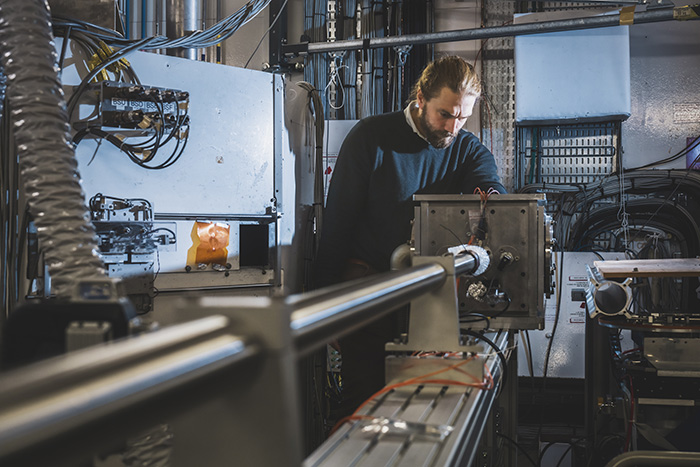- Home
- News
- General News
- Towards improving...
Towards improving carbon dioxide storage by understanding complex fluid behaviours
02-01-2024
Researchers from the Norwegian University of Science and Technology (NTNU), in collaboration with the ESRF, have used high-speed stroboscopic X-ray microtomography to better understand how fluids flow inside porous media, such as in natural carbon dioxide storage systems. The research features in PNAS.
Underground CO2 storage is a particularly researched subject in the times that we are living due to the changes in climate that the world is going through. Finding ways of storing CO2 would cut down emissions, which directly influence the climate crisis. Storage in abandoned gas reservoirs is currently challenging to implement, partly because of the lack of specific knowledge on how fluids flow inside porous rocks. It is a delicate process, because at the severe underground conditions of high pressure and temperature, CO2 is in its supercritical state, which is neither liquid nor gas, and it will replace the salty water (brine) that resides in the porous rock. This means that there are several fluids involved, so-called multiphase flow, which is qualitatively different from the situation when there is just one fluid.
CO2 storage is but one example where multiphase flow takes place, and there are many others in geology and environmental science, such as in soil remediation and safe nuclear waste storage, but also in processing industry with, for example, flow in porous catalysts and membrane-based fuel cells, and also in biological processes.
A liquid in a porous medium can be either wetting, meaning that it tends to spread out, or non-wetting, implying that it prefers to form clusters or droplets on its own. In the familiar process of drainage, a non-wetting fluid replaces a wetting fluid. Despite its apparent simplicity, inside a porous material, the process of drainage is actually highly complicated.
“The problem is that when you do drainage with fluids that do not mix, instabilities can arise. In addition, geological samples are quite complex also because the fluids have to pass through an interlaced network of spacious pores and narrow throat openings, so it is not only the type of the fluid, but also the microstructure of the host medium that plays a key role in promoting this instability”, explains Bratislav Lukic, scientist at the ESRF and co-author of the paper. There are also other parameters influencing this process, such as the local mineralogy and how fast the liquids move in the porous medium.
The drainage of porous rocks is not a smooth process. There can be a jump when the invading liquid suddenly fills a new pore, instead of flowing in a continuous way. This is recognised as a Haines jump, which was described by physicist William B. Haines in 1930. However, because Haines jumps take place inside generally opaque porous media, within small pores with length-scales of millimeters and during timescales of milliseconds, they have never previously been observed in 3D at their native time and length scales. The Haines jumps potentially affect the efficiency (permeability) of the fluid flow, and hence the CO2 storage capacity or the efficiency of porous catalysts. Today’s advanced computer models need calibration with experimental data to accurately predict how and when the jumps will happen.
Now scientists at the Norwegian University of Science and Technology (NTNU) in collaboration with the ESRF have carried out experiments investigating Haines jumps during water drainage in a heterogeneous porous medium consisting of sintered glass shards.
The team has characterised the different steps of Haines jumps in time-resolved 3D using imaging capabilities of the beamline ID19, revealing that a typical jump lasts about 20 milliseconds. The sub-millisecond temporal resolution is several orders of magnitude faster than what has previously been reported in the literature, enabling new observations like details of the pore filling dynamics to be observed for the first time.
 |
|
Bratislav Lukic carrying out experiments on ID19. Credits: S. Candé. |
“With this study we have managed to carry out a steady imaging experiment of an inherently unsteady and fast phenomenon, using high-speed radiography at different observation angles”, says Kim Tekseth, from the NTNU and first author of the paper. “The key to the success of our experiment was that we managed to make the drainage dynamics repeatable. In other words, each Haines jump which is reconstructed in 3D, is in reality a systematic combination of different Haines jumps observed from different angles.” This stroboscopic tomography technique enabled the researchers to get a 3D movie using advanced reconstruction methods. “This beamline is unique because it provides high flux at high X-ray energies, able to access deep into the microscale structure of natural and complex samples”, Tekseth.
The next steps for the team involve working with different liquids, injection rates and more relevant porous materials, for example, real rocks representative for large-scale CO2 storage sites. “There are several countries studying different options to bury CO2 and we want to contribute to the feasibility of these storage solutions by finding out how fluid displacement takes place. By studying samples from real sites, we will be able to better predict these behaviours”, concludes Dag Breiby, professor at NTNU and corresponding author of the publication.
Reference:
Tekseth, K.R. et al, PNAS, 25 December 2023. DOI 10.1073/pnas.2305890120
Text by Montserrat Capellas Espuny
Top image: The picture shows how the intruding air, the fluid that displaces water, after penetrating extremely fast in one direction, it then pauses and changes its direction, all this happening at millisecond time scales and microscopic spatial scales. Credits: PNAS.



